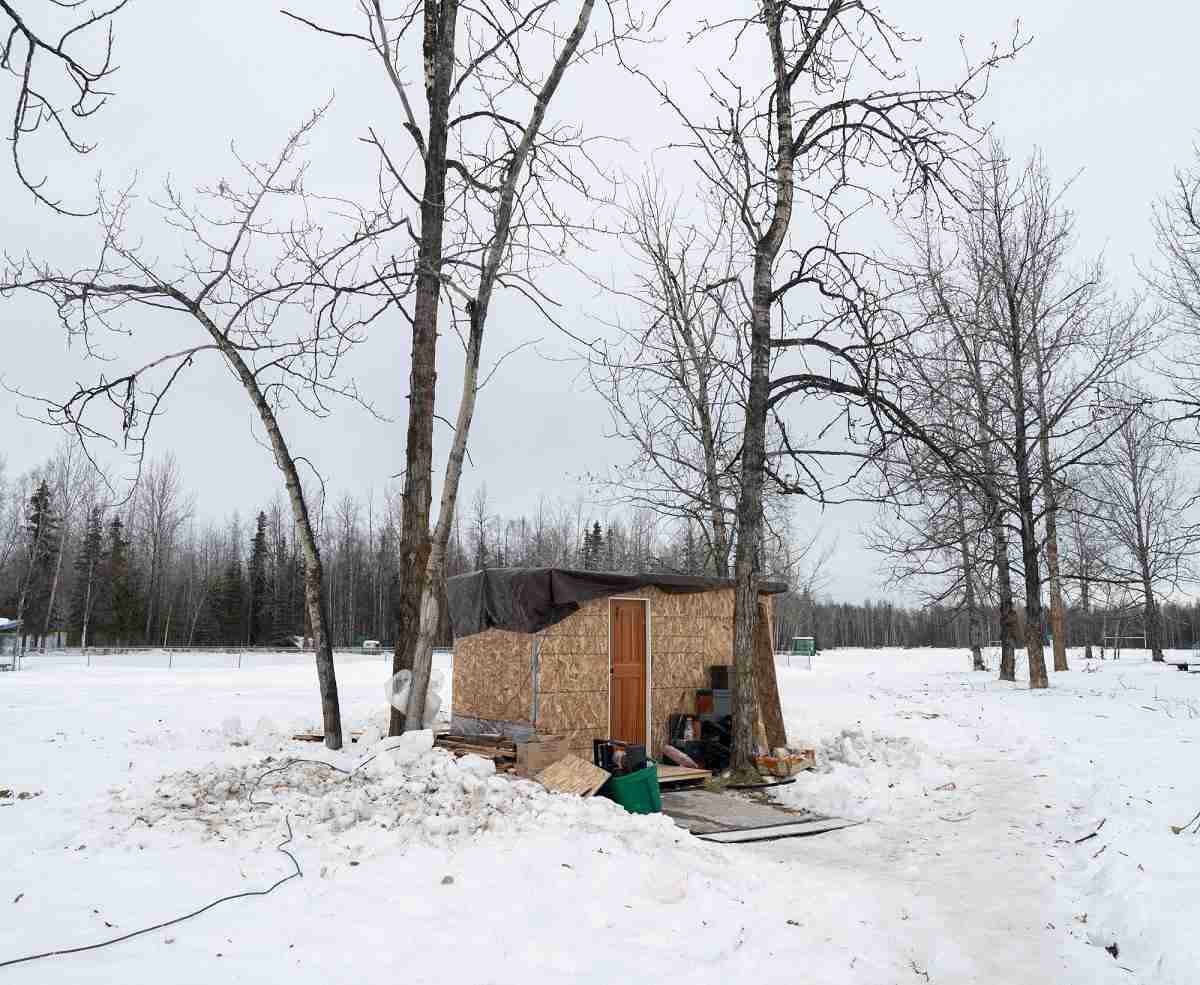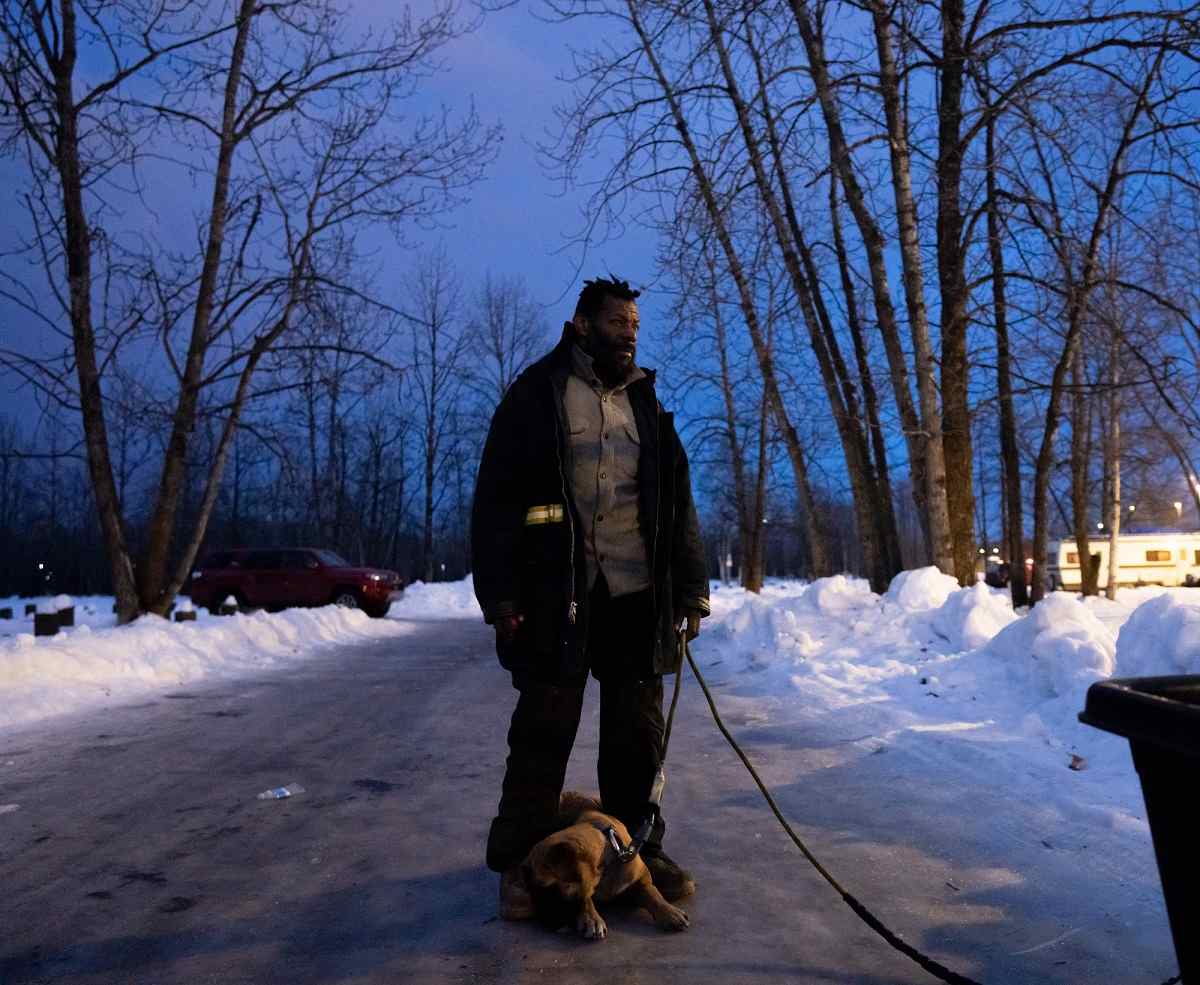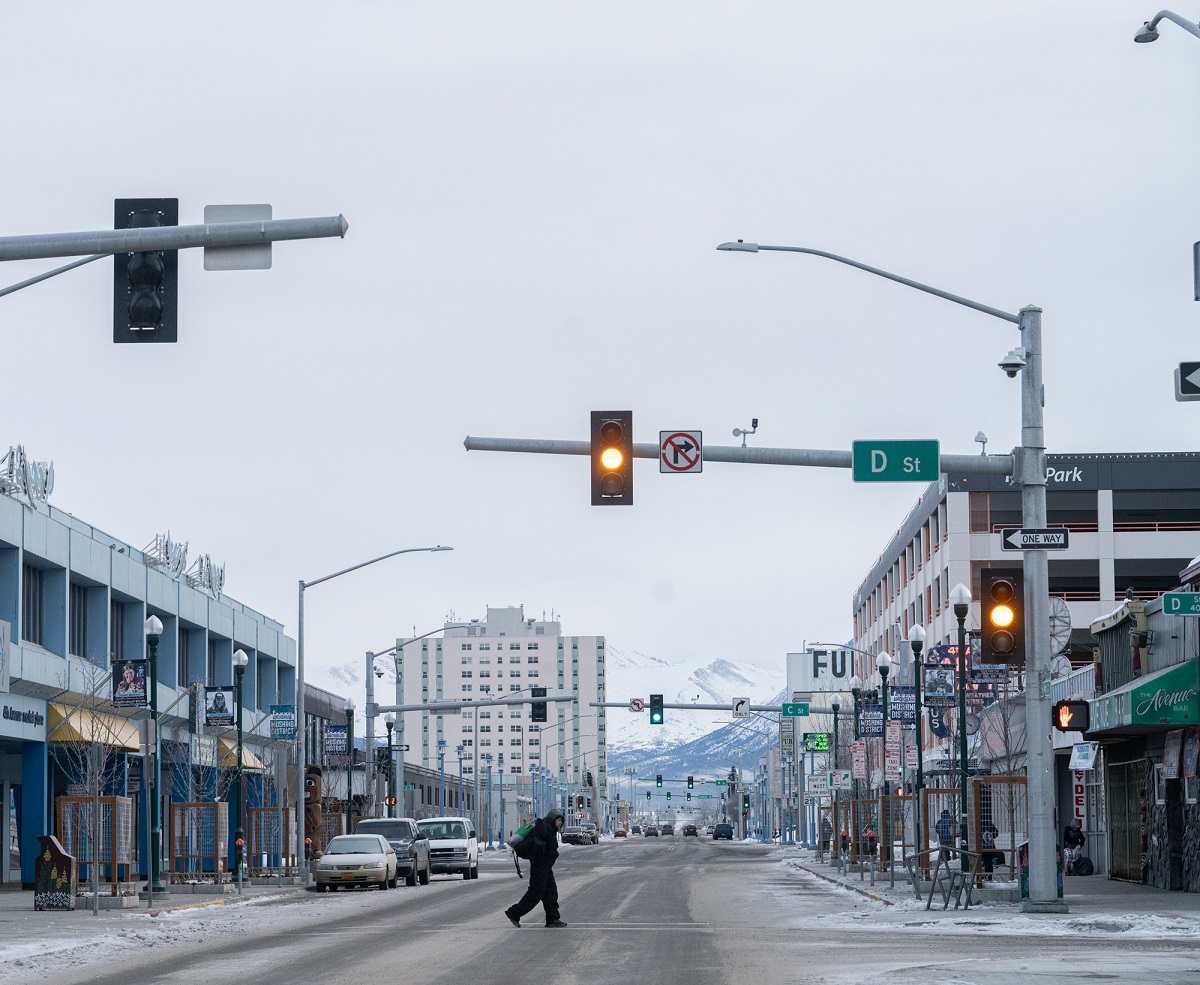
A structure where a homeless person lives, on Nov. 29, 2023, in Anchorage.
17:48 JST, December 17, 2023
ANCHORAGE – Near the end of the snowiest year on record for Alaska’s largest city, Larry Tunley took a plastic box tied to an old boogie board and pulled the makeshift sled through the trees to collect wood.
Tunley lives under a tarp in a homeless camp on the north side of the city, one of hundreds of people who spend the winter outdoors in Anchorage. The season’s snowstorms had made his tenuous living situation even more perilous: Tents gave way under the heavy drifts; tree limbs crashed down. During a cold snap last month, at least four people in the city died from exposure or through their attempts to stay warm, according to police and advocates for the homeless. Tunley’s neighbors huddled together around propane flames or shared body heat to withstand the elements.
“We all pull together, like America’s supposed to,” he said in the snow-draped woods as he chopped up a fallen tree with a machete.

Larry Tunley, 49, stand for a portrait with his dog Kea in Anchorage on Nov. 28, 2023, before heading into the forest to chop wood.
Even the hardy souls accustomed to enduring Alaskan winters have been tested by the recent onslaught of extreme precipitation – part of a pattern that climate scientists predict will worsen as the atmosphere warms. Over the past two years, storms starting in warmer-than-normal waters of the Pacific have hit Anchorage with rain and snow on a scale that has little precedent in the state’s recent history. Last year was the wettest in the record dating back to 1953, according to the National Weather Service office here. This year is already the fourth-wettest and could move higher.
This period is so far above average that “it’s almost like getting three years’ worth of precipitation in a two-year span,” said Tim Markle, a Weather Service meteorologist in Anchorage.
The downpour – in the form of both snow and rain – is in line with trends facing Alaska and other northern regions in a warming world, according to the federal government’s most recent National Climate Assessment. The state’s average annual precipitation is projected to increase by 20 percent by the end of the century under an intermediate emissions future, the report said, warning of more extreme events.
Heavy rain and wind in the coastal community of Wrangell last month prompted a landslide that killed at least 5 people, including two children, when a swath of forested hillside more than 400 feet wide slid into the sea.
“At high latitudes, the climate models are basically unanimous on increasing annual precipitation,” said Rick Thoman, a climate scientist at the International Arctic Research Center at the University of Alaska at Fairbanks. “Really, the big story is the increasing extreme precipitation.”
Anchorage doesn’t typically have a snowstorm of more than 6 inches in November. But that’s happened on four separate days last month – plus another storm that left up to a foot of snow last week. The biggest dump came Nov. 8 and 9, dropping more than 2 feet of snow in some areas. It was disruptive even for a city accustomed to harsh winters. School went online for several days. Businesses closed. Many residents complained about being trapped in their neighborhoods as plowing dragged on for days.
“It has really impacted everyone,” said Felix Rivera, a member of the Anchorage Assembly. “We as a local government need to be prepared for this to be somewhat of a new normal.”
The snow and subsequent cold weather hit particularly hard for those living outside. Anchorage’s homeless population has multiplied in recent years, driven by pandemic economic disruptions and a surge in fentanyl use, according to social service providers here, and the city has struggled to shelter all those living on the streets as winter approaches.
In May, the city closed the Sullivan Arena, a former hockey stadium that had been converted into a homeless shelter in 2020. It housed up to 500 people but suffered with drug use and other crimes, and generated opposition among neighbors. Within days of the shelter’s closure, homeless deaths began to mount, and risks grew as temperatures plunged.
During a frigid stretch in early November, Alfred Koonaloak, 61, was found dead in a sidewalk alcove of a downtown gift shop. Known as “Uncle Al” by other homeless people and advocates, he used a wheelchair and regularly slept downtown. But he would take refuge in shelters when nights turned too cold, according to homeless advocates who knew him.
Another homeless man in a wheelchair had died outdoors the day before; the day after, a man in a tent was found dead. For the year, the homeless death toll has grown to at least 50 people, a record number, said Shawn Hays, executive director of Henning Inc., the nonprofit that runs the city’s shelters and had operated the Sullivan Arena shelter.
“It was heart-wrenching for us, for staff, to discharge hundreds of people out onto the street,” Hays said.
“We knew there were going to be ramifications,” added Rob Seay, Henning’s deputy director. “We didn’t think it would hit that fast. That hard.”
In October, the city opened a new cold weather shelter in a former vehicle depot of Anchorage’s trash removal agency and also relies on two hotels for bed space. Mayor David Bronson, a Republican, has pushed for building a large tent that could house up to 1,000 people, but the city’s assembly, controlled by Democrats, rejected the plan because of concerns about cost and problems from housing so many people together.
For now, the available shelters are full while hundreds of people are still living outside in tent camps, on trails, in downtown doorways.
“There are hundreds that are at risk of dying,” Hays said.
‘The scariest thing I’ve had happen out here’
On the morning of Nov. 9, snow measurement duties at the National Weather Service’s Anchorage office fell to Michael Kutz, a hydrometeorological technician with nearly a half-century working in weather. To keep faithful records, an employee checks for new precipitation every six hours of every day.
The snow had started coming down the day before, and Kutz’s job was to probe the drifts behind the office with a ruler and collect the metal canister used to calculate how much water the new snow contained.
What he encountered that morning was a surprise even for a seasoned veteran.
“There’s wild, and there’s wild on steroids,” he recalled.
The storm had originated in a part of the Pacific Ocean south of the Aleutian Islands where surface temperatures have been anomalously warm for this time of year. With warmer temperatures, more moisture is available for storms. As this atmospheric river approached, forecasters were unsure if it would hit Anchorage as snow or rain.
Over the past 70 years, Anchorage has warmed 4.2 degrees Fahrenheit, according to National Oceanic and Atmospheric Administration temperature data taken from the airport, driven by humans burning fossil fuels. And November was one of Alaska’s warmest months on record. During the Nov. 8-9 storm, temperatures hovered right around freezing, just cold enough to deliver snow.
“A lot of people aren’t joking when they say, ‘Well, what global warming? Look at all that snow,'” said Brian Brettschneider, Alaska region climate scientist with the National Weather Service office here. “But every single day it snowed was above normal.”
On the morning of the big snow, Anchorage police responded to a tent on fire less than a mile from the city’s new cold weather shelter. Police said it appeared to be caused by an open flame in the tent. They tried to resuscitate the woman inside – Marion Gessells, 57 – but she died.
The heavy, wet snow fell like a thick blanket on the homeless encampment near Davis Park in a patch of woods off Mountain View Drive. When several tents caved in during the storm, Sophie Wodekowski, 34, said she helped dig people out. Then a spruce tree branch crashed down on her.
“It’s probably the scariest thing I’ve had happen out here,” she said. “Because I’m not very big. It definitely took three of us to get it off me.”
“If there hadn’t been anybody else there I would have been stuck,” she said.
One of the leaders of the homeless camp, Brian Vaughan, 54, said he allowed several people to shelter with him to ride out the storm. Vaughan lives under a car canopy wrapped in plastic with a floor of pallets and plywood. He calls it “the clubhouse,” and his neighbors convene there to warm themselves by the low propane flame burning inside.
Last year, one of them lost a toe from frostbite. During a particularly cold stretch last month, Vaughan said a dozen people were sharing his shelter to stay warm.
“My old man, he’d kill me if I turned anybody away at the door who was cold,” he said.
Vaughan said he moved to Alaska from coastal North Carolina in the 1980s, following a relative stationed at the Air Force base in Anchorage. He’s worked as an auto mechanic, a mover, a house painter, in fast-food restaurants and at canneries. He’s open about his struggles with drug use and alcohol and has been homeless in this area for several years.
Vaughan is one of dozens of people living in makeshift housing in and around Davis Park. The city had planned to clear the encampment last year but suspended its plans after a lawsuit by the American Civil Liberties Union, arguing the city can’t move people from public spaces if there is no place to go.
“Everyone’s always carrying on about us camping,” said Vaughan, who is a plaintiff in the suit. “We’re not camping. We’re living.”
‘It’s climate change, global warming’
It was late afternoon, but already dark, on the day Tunley pulled his sled through an icy parking lot and headed back into the trees. He lived in the tent behind Vaughan’s and had borrowed his wood stove. Born and raised in Alaska, Tunley said he’d been homeless for four or five years.
He passed a shopping cart partially buried in snow. Then the front seat torn from a car. When he came upon a downed pine tree, he took out his machete and began chopping it up. Another man stepped out from the woods.
Surviving an Alaska winter, Jose Barrera said, requires “a lot of trees.”
He lives in a teepee fashioned from felled trees, now insulated with a blanket of snow. After eight years homeless in the area – and nearly two decades in Alaska – he can tell winters are getting milder, and he prefers snow to cold.
“The only thing I actually really do notice is just the fact that it is getting warmer,” Barrera said. “It’s climate change, global warming, they’ve been denying it for so long.”
A former U.S. Marine, Barrera, 51, is confident in his survival skills even in the worst storms. He eats from dumpsters, finds clothes where he can. The growing homeless population around him, many of them younger and struggling with drugs, may have more problems, he said.
“It doesn’t help that a lot of us are broken,” he said. “We’re broken from whatever events happened in our lives.”
“I ain’t broken,” Tunley said, as he hacked at the tree.
“In one way or another, man, we’re trying to fix ourselves,” Barrera said.
“Don’t need fixing,” Tunley said.
Tunley finished loading up his sled with firewood. His face was shiny from the effort. The cars in the distance sounded like a rushing river. The only other sound was someone else, far off, chopping logs in the snow.

A person crosses Fourth Avenue in Anchorage on Dec. 2, 2023.
"News Services" POPULAR ARTICLE
-

American Playwright Jeremy O. Harris Arrested in Japan on Alleged Drug Smuggling
-

Japan’s Nikkei Stock Average as JGB Yields, Yen Rise on Rate-Hike Bets
-

Japan’s Nikkei Stock Average Licks Wounds after Selloff Sparked by BOJ Hike Bets (UPDATE 1)
-

Japanese Bond Yields Zoom, Stocks Slide as Rate Hike Looms
-

Japan’s Nikkei Stock Average Buoyed by Stable Yen; SoftBank’s Slide Caps Gains (UPDATE 1)
JN ACCESS RANKING
-

Keidanren Chairman Yoshinobu Tsutsui Visits Kashiwazaki-Kariwa Nuclear Power Plant; Inspects New Emergency Safety System
-

Imports of Rare Earths from China Facing Delays, May Be Caused by Deterioration of Japan-China Relations
-

University of Tokyo Professor Discusses Japanese Economic Security in Interview Ahead of Forum
-

Japan Pulls out of Vietnam Nuclear Project, Complicating Hanoi’s Power Plans
-

Govt Aims to Expand NISA Program Lineup, Abolish Age Restriction
























